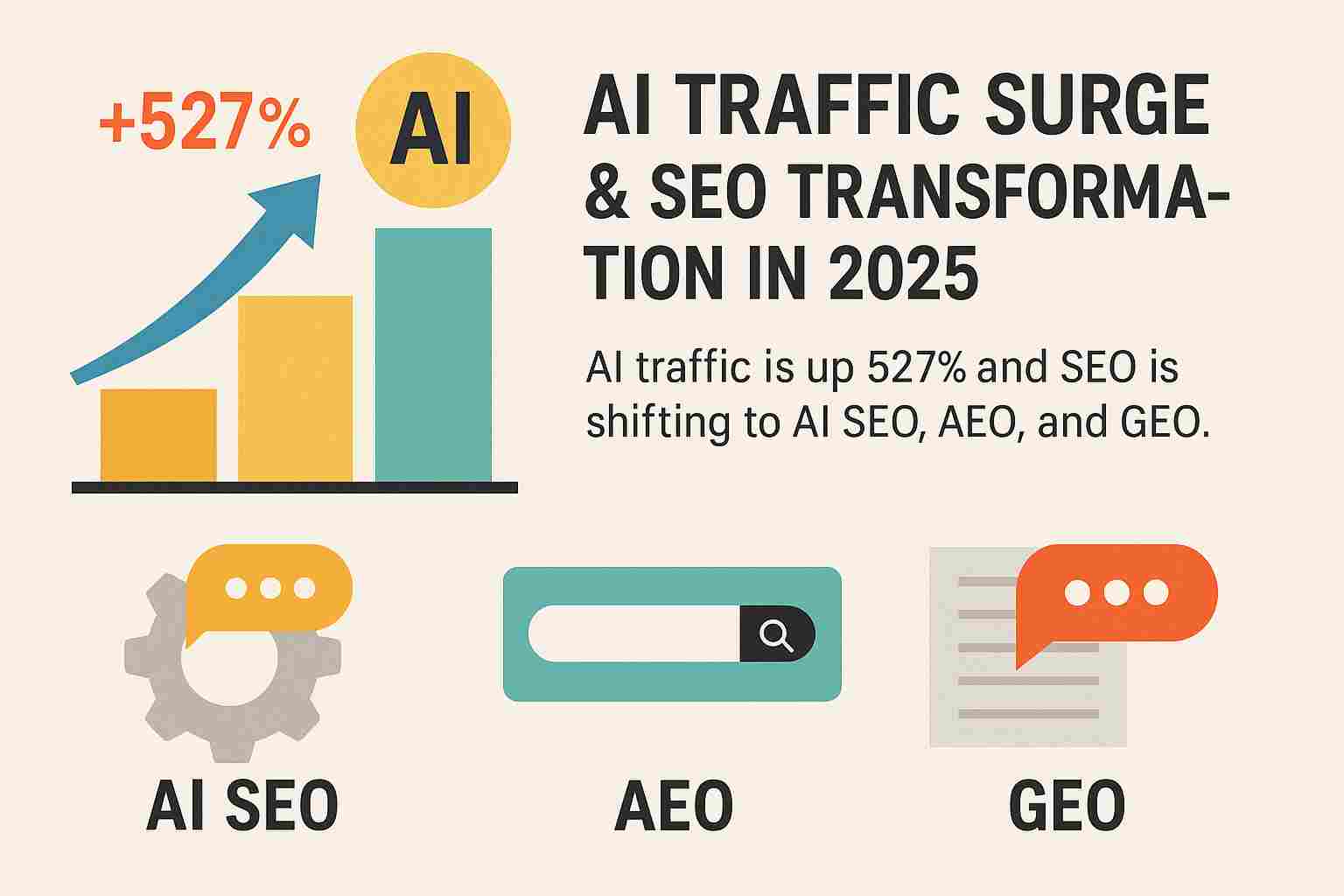Introduction
Ever wondered why your web traffic suddenly feels… off? Well, buckle up because AI-generated answers are stealing the show. In early 2025, AI‑referred sessions jumped 527% between January and May, according to the Previsible AI Traffic Report. That means people are getting answers from ChatGPT, Claude, Gemini, and Copilot instead of clicking through to your site. SEO as we know it is being rewritten and now’s the moment to adapt.
What exactly is AI traffic and why should you care?
AI traffic refers to visitors arriving at your site via referrals from large language model tools like ChatGPT, Google AI Mode, and Perplexity. These tools now summarize and deliver answers directly, bypassing typical search results. A stunning 1 in 100 sessions on some SaaS sites now comes from LLM traffic. If you rely on organic search traffic, that’s a game‑changer.
How is traditional SEO changing with AI SEO and AEO?
Traditional SEO is shifting toward AI SEO and Answer Engine Optimization (AEO). AI SEO blends machine learning with keyword analysis, while AEO focuses on crafting content that large language models will pull into their conversation‑style answers. So instead of just optimizing for backlinks and keywords, you now optimize for how AI systems pick and present your content. This is where adapting your content for modern search formats becomes essential our guide on optimizing content for modern search formats covers exactly how to do that.
Why is Generative Engine Optimization (GEO) becoming a thing?
Generative Engine Optimization (GEO) is the new frontier: optimizing content so it gets cited by AI‑powered chatbots like Gemini or Claude within synthesized answers instead of just ranking on Google’s SERPs. Tactics include structured data, llms.txt files, and conversational content that AI language models love to quote. Brands that embrace GEO alongside traditional SEO are finding they can maintain visibility in both search results and AI answer boxes.
What do experts say about this shift?
“As content strategist Nina Lopez says, ‘AI won’t replace writers, but writers who use AI might replace those who don’t.’” Similarly, marketers report that technical factors page speed, structured metadata, and crawlable code are now more critical for visibility in AI‑driven contexts than ever before. Even Google has hinted that conversational contentand AI content strategy will play a bigger role in rankings.
How can you update your strategy to survive this transformation?
- Audit your site for robots.txt, llms.txt, structured markup, and page load speed AI crawlers value clean, accessible code more than flashy designs.
- Shift to conversational writing, especially in FAQs and how‑to guides it’s what AEO and GEO prefer.
- Use AI tools to analyze competitors and discover content gaps this helps you spot where your competitors are outranking you in AI search results.
- Create Q&A‑friendly content and structured data so AI summarizers can pull your content directly. Our post on structured data to improve visibility is a great place to start.
- Monitor metrics beyond rankings track LLM referral traffic, AI citations, and homepage impressions, not just SERP positions. You can learn more about these changes in this Search Engine Journal guide on AEO and GEO strategies.
Conclusion
In short: AI is rewriting SEO. If you’re not thinking about AI SEO, AEO, and GEO, you’re already behind. The early adopters are winning will you be one of them? Let me know what questions you have or share this if you found it useful.
FAQ
It’s visits coming via LLM platforms like ChatGPT or Google AI Mode, instead of organic search.
Absolutely traditional SEO for backlinks and keywords is still vital, but now you layer on AEO and GEO tactics too.
Use GA4 or analytics with custom tracking for incoming traffic from “chatbot” referral paths.
Yes! Tools like Surfer, Semrush, and RankIQ help you audit content, analyze competitors, and optimize conversational structure.
Studies predict that by 2028, AI referrals may surpass traditional search traffic for many topics.
